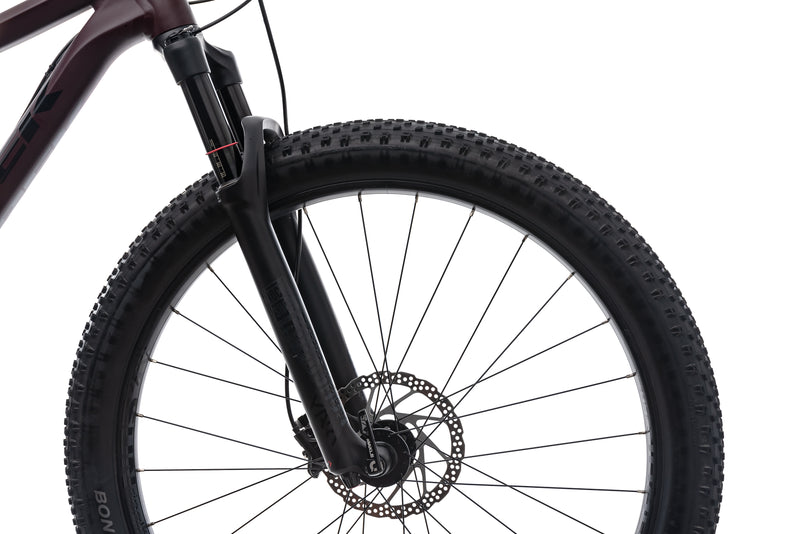

Shimano’s version of this derailleur is called the “Shadow Plus.” Both SRAM and Shimano use the same basic principle – adding a clutch mechanism to the rear derailleur to add chain tension. I can remember on multiple occasions dropping a chain while ascending or descending stairs. The SRAM X9 type-2 rear derailleur is a welcome addition, as it significantly reduces chain-slap and dropped chains. This simplifies the drive train substantially, and reduces cross chaining. Instead of three chain rings, there are only two. I love that this bike has a 2X10 drive train. Thru-axles virtually eliminate this difficulty, because if things aren’t lined up right it won’t go in. How many times have you maybe not set your 9mm quick release quite right, or know other officers who have struggled? This can create a potential hazard to the rider if the quick release isn’t installed correctly.
#TREK STACHE 7 PRICE INSTALL#
Furthermore, thru-axles are nearly impossible to install wrong. Thru-axles add durability and stiffness to the bike, keeping it on track during hard cornering and obstacle clearance. One of the things that I love about this bike is the thru-axles I mentioned in the specs section. The slacker geometry of this bike, along with the 120mm travel fork, made dicey stair descents and other obstacles much easier to ride as well. I could complete stair ascents with ease that I was having more difficulty on with my old 26-inch wheeled bike. The 29er wheels allowed for easy obstacle clearance. I set out on this bike and quickly found it to be a joy to ride on duty. I converted my wheels and tires to tubeless as a personal preference (see my article on this at ). These tires are rather beefy, providing great traction combined with a low rolling resistance. As I mentioned earlier, we changed out the stock knobby tires with a set of Maxxis Hookworm 29 X 2.5” tires. I was lucky enough to have one of our purchases assigned to me. It didn’t take much convincing of my chain of command to purchase two 2014 Trek Stache 7 models in “Trans Blue.” I was so impressed with the bike’s handling and durability that I thought it would be a perfect match for public safety cycling. I currently enjoy trail riding on a regular basis, and actually purchased a 2013 Trek Stache 7 last year. In my opinion, this is one of the best all-around bikes I have ever ridden. We also equipped our bikes with a Topeak MTX trunk and seat-post mounted rack. If you are thinking about adding a dropper seat-post, Trek has integrated internal routing for a stealth post as well. The tires are knobby and trail-oriented, so we had these swapped out for a set of Maxxis Hookworm 29X2.5 tires. Trek puts the rubber to the road with their house-brand Bontrager Duster 29 wheels and Bontrager 29er XR3 Expert tires. Even though they are considered entry-level brakes, they provide adequate and consistent stopping power. The brakes are Shimano’s entry-level hydraulic M445 brakes with a 160mm rear disc and 180mm front disc. Trek has utilized internal cable routing for the drive train. The drive train is a mixture of mid-level SRAM and Race Face components, utilizing a 2X10 drive train equipped with a SRAM X9 type-2 rear derailleur.

The bike features Trek’s “e2” tapered headset, which also adds a bit of durability and stiffness to the front end. These axles are beefier than the standard 9mm quick-release axles found on a vast majority of police bikes, allowing for more durability and stiffness. The bike utilizes a 15mm thru-axle in front and a 142-12mm axle in the rear. It sports a 120mm Rockshox Recon Silver air-sprung fork with 32mm stanchions. The Trek Stache 7 is equipped with a healthy and robust mix of components. I found this to be advantageous to typical police cyclist riding environments as well. This geometry allows the rider a more stable platform for riding over the ever-changing environment of trails. The geometry of the Trek Stache models is a bit slacker than their cross-country bikes, including a longer travel (120mm) fork. Trek was a very early adopter of 29er technology, and their years of experience have enabled them to refine the geometry of their bikes, using what they call G2 geometry. The Trek Stache is a trail-oriented, hard tail 29er. The Trek Stache 7 is in the middle, offering a good component spec while maintaining a low price. For 2014, Trek offered three versions of the bike, with varying component specs (models 6, 7, and 8). By Jared Williams, PCI #1214, Tacoma (WA) Police Department, IPMBA Industry Relations CommitteeĢ014 marked the second year of production for the Trek Stache model.


 0 kommentar(er)
0 kommentar(er)
